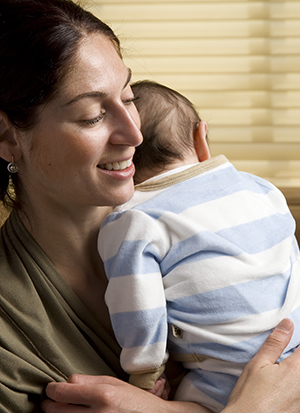After a Vaginal Birth
After having a baby, your body may be very tired. It can take time to recover.. You may stay in the hospital from 1 to 4 days. In some cases, you may be able to go home the same day.

Right after the delivery
Your temperature and blood pressure will be checked until they are stable. A nurse or other healthcare provider will watch you as you rest. You may have afterbirth pains. These are cramps caused by the uterus shrinking. Sanitary pads are used to soak up the discharge of the uterine lining. To make sure that you aren’t bleeding too much, the pad will be checked. And the firmness of your uterus will be checked. To do this, a nurse will gently push down on your stomach. If you had anesthesia, you’ll be watched closely until you can feel and move your toes. If you have pain between your vagina and anus (perineal pain), an ice pack can help.
Newborn care
While still in the hospital or birth center, you’ll learn how to hold and feed your baby. You will also be given directions on how to care for your baby. This includes bathing and feeding.
Getting ready to go home
You may be anxious to go home as soon as possible. Before you and your baby go home, a healthcare provider will check to be sure you are healthy enough to take care of your baby and yourself. You’re ready to go home when:
-
You can walk to and use the bathroom without help.
-
You can eat solid food and swallow pills (if needed).
-
You have no sign of infection or other health problems, including fever.
-
You have pain control.
-
Your vaginal bleeding isn't heavy.
-
You are able to care for your newborn and are emotionally stable.
Before going home, you’ll be given written directions for home self-care after vaginal delivery. Follow these directions carefully. If you have questions or concerns, talk about them now.
If you have stitches
You may have get stitches in the skin near your vagina. The stitches might have closed an incision that enlarged the opening of your vagina (episiotomy). Or you may have needed stitches to repair torn skin. Either way, your stitches should dissolve in weeks. Until then, it's important to keep the stitches clean. You can help reduce mild pain, aid healing, and reduce your risk of infection. These tips can help:
-
Gently wipe from front to back after you urinate or have a bowel movement.
-
After wiping, spray warm water on the area. Or you can have a sitz bath. This means sitting in a tub with a few inches of water in it. Then pat the area dry or use a hairdryer on a cool setting.
-
Follow your healthcare team's specific cleansing instructions about using soap or medicines on the area.
-
You can take a shower unless told not to.
-
Change sanitary pads at least every 2 to 4 hours.
-
Place cold or heat packs on the area as directed by your healthcare providers or nurses. Keep a thin towel between the pack and your skin.
-
Sit on firm seats so the stitches pull less.
Postnatal follow-up
Schedule a postnatal follow-up exam with your healthcare provider for about 6 weeks after delivery. During this exam, your uterus and vaginal area will be checked. Contact your provider if you think you or your baby are having any problems.
When to call your healthcare provider
Call your healthcare provider right away if any of the following occur:
-
A fever of 100.4° F ( 38.0°C) or higher, or as directed by your provider
-
Bleeding that needs a new sanitary pad after an hour, or large blood clots. Postpartum hemorrhage is more bleeding than normal after the birth of a baby. It most often happens after the placenta is delivered. But it can also happen later.
-
Pain in your vagina that gets worse and isn't eased with medicine
-
Swelling, discharge, or more pain from vaginal tear or episiotomy
-
Burning, pain, red streaks, or lumpy areas in your breasts that may occur with flu-like symptoms
-
Cracks, blisters, or blood on your nipples
-
Burning or pain when you urinate
-
Nausea or vomiting
-
Dizziness or fainting
-
Feelings of extreme sadness or anxiety, or a feeling that you don’t want to be with your baby
-
Belly pain that isn’t eased with medicine
-
Vaginal discharge that has a bad odor
-
No bowel movement for 5 days
-
Painful urination, or inability to control urination
-
Redness, warmth, or pain in the lower leg
-
Chest pain
Online Medical Reviewer:
Donna Freeborn PhD CNM FNP
Online Medical Reviewer:
Heather M Trevino BSN RNC
Online Medical Reviewer:
Irina Burd MD PhD
Date Last Reviewed:
12/1/2022
© 2000-2024 The StayWell Company, LLC. All rights reserved. This information is not intended as a substitute for professional medical care. Always follow your healthcare professional's instructions.